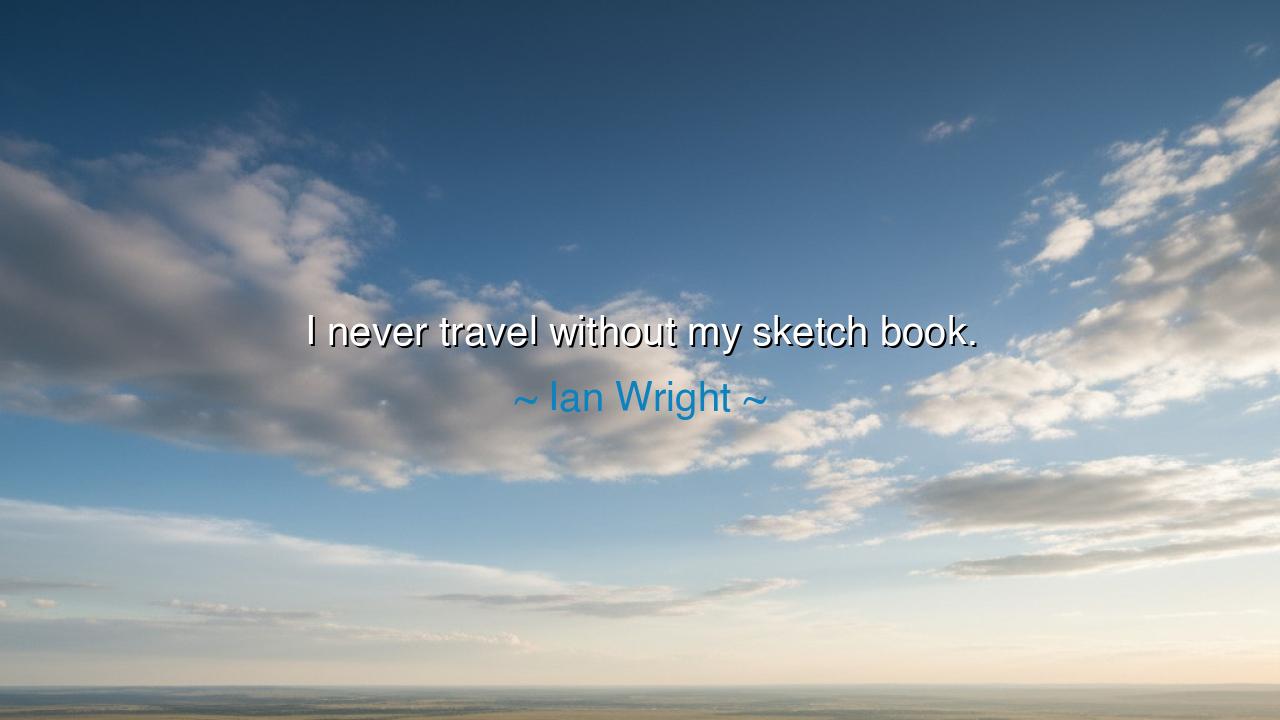
I never travel without my sketch book.






The words of Ian Wright — “I never travel without my sketch book.” — carry a wisdom that is both simple and profound. They reveal the soul of an artist who does not see the world merely as a place to pass through, but as a canvas, alive with forms, colors, and stories waiting to be captured. To him, the sketch book is not a tool of vanity, but a vessel, a sacred companion through which fleeting moments are made eternal. For the eye alone forgets, but the hand that draws makes memory immortal.
In this declaration we hear an echo of the ancients. For long before the camera, before the pen of the journalist or the lens of the traveler, there was the hand of the artist. Cave walls in Lascaux, etched with beasts of the hunt; the scrolls of China, painted with rivers and mountains; the illuminated manuscripts of monks — all were born of the same impulse: to seize upon the wonder of the world and preserve it. Ian Wright walks in this lineage, carrying his sketch book as one might carry fire, ready to light the flame of memory wherever he journeys.
To travel with such a companion is to see differently. Where others pass swiftly, consumed by schedules and destinations, the one who sketches must pause, must look deeply, must truly see. A street corner becomes more than stone and shadow; a face glimpsed in a crowd becomes a study of humanity. The sketch book transforms travel from mere motion into meditation, forcing the soul to dwell, to absorb, to render. And in that act, the traveler ceases to be a stranger and becomes a witness.
History offers many noble examples of this practice. Leonardo da Vinci, wherever he wandered, carried notebooks filled with drawings of machines, bodies, and the natural world. His sketches were not idle scribbles, but revelations that still astonish centuries later. Captain James Cook brought with him artists on his voyages, who sketched lands and peoples unknown to Europe, preserving images that words alone could never hold. Even soldiers at war have kept sketch books, capturing the human face amid devastation, so that future generations would not forget. Each example shows that the drawn line carries a weight of truth beyond words.
Yet Wright’s words are not only about art — they are about presence. To carry a sketch book is to declare: “I will not let this journey slip by unnoticed. I will honor it.” How many of us travel, yet never truly look? How many sights fade from memory as if they had never been? But he who draws forces himself into intimacy with the world. Each line on the page is a covenant with reality: I was here. I saw. I remembered. In this way, the sketch book becomes a mirror of the soul, and the journey itself becomes an act of devotion.
The lesson is clear: do not pass through life as a shadow. Find your own sketch book, whatever form it may take — whether drawing, writing, photography, or simple reflection. Give permanence to the fleeting, and meaning to the ordinary. You need not be an artist to preserve beauty; you need only the will to pause and the courage to see. For it is not the grand monuments alone that shape our lives, but the small, unremembered corners, captured and cherished.
Practical wisdom follows. When you travel, carry with you a tool to record — a notebook, a pen, a camera, or simply the practice of silence and memory. Set aside time not only to go but to see, not only to see but to preserve. Reflect on your journeys, record your thoughts, sketch your impressions. In doing so, you will transform travel from motion into meaning, from passing time into eternal treasure.
So remember, child of tomorrow: the world is vast, but the memory is fragile. Do not let beauty pass unmarked. Carry your sketch book — in hand or in spirit — and let each journey leave its indelible trace upon your soul. For in that act, you honor both the road and yourself, joining the eternal brotherhood of wanderers who refuse to let wonder vanish into silence.






AAdministratorAdministrator
Welcome, honored guests. Please leave a comment, we will respond soon